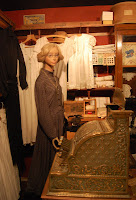
Located in a charming Wealden Hall House dating back to the 15th century, the museum tells a fascinating story of life through the ages from the reign of Queen...
Thanks to Our Forest Row friends to offer us this fantastic visit.
This trip to Yesterday’s World offers visitors a unique insight into the past; cleverly created through a series of vividly recreated walk through displays. Experience the look, feel and taste of "how we lived then" at the turn of the century and beyond.

Queen Victoria was Britain's longest reigning monarch.
She reigned for 63 years from 1837-1901.



Allwork's Store
The oldest general store at Yesterday's World dates from the late 19th century before pre-packaging was introduced, when all goods (including coffee, tea, treacle and tobacco) were weighed out by hand.








Pepper's Boutique (1960s-1970s)
A ‘pop-art’ shop, similar to that found in Carnaby Street years ago, selling records, clothes and fashionable accessories from the psychedelic era.Feast your eyes on the riot of colour – tangerine, puce, deep purple and violet clash for space, making a bold statement for ‘choice’.


Children's Historical Play Village
A charming miniature play village is a firm favourite with our younger visitors. The charming hand-crafted buildings include a village store, church, an inn, an old fashioned school house complete with miniature desks, a blacksmith's forge with light up coals and a turreted castle with dungeons!

1930's Wireless Shop
The British Broadcasting Company (BBC) first started regular broadcasts in 1922, from the Marconi 2LO transmitter in London. In the 1930’s wireless shop a vast selection of valves, radios, batteries and light bulbs from the period is on display.

Mrs Bumble's Chocolate Shop
The confectionery shop, with its delicious aroma, is filled with traditional sweets and packaging as it would have been sold in the 1920s. Gobstoppers, liquorice root, giant humbugs, barley twists and other colourful candies could be bought for half a penny in a paper twist. Don’t forget a visit to the traditional Victorian Sweet Shop where you can choose from a wide range of traditional sweets, home made fudge, jams and marmalades.


Doll & Toy Shop
German manufacturers had a monopoly on china dolls, many of which were modelled on real children and became very popular before the First World War. They sold for 2s.6d.each which was a young man's weekly wage then.Toy bears had been made in Germany since the 1840's; they were always stiff, sawdust-stuffed animals, until 1902 when Steiff introduced a softer fur covered bear. The name, Teddy, was attached to it, after a cartoon appeared of Teddy Roosevelt, the American President, taking home a baby bear as a pet, after one of his hunting trips.The doll and toy shop contains many fine examples of both boys' and girls' toys spanning over a hundred years.




Victorian Kitchen
With the Industrial Revolution a host of labour saving gadgets for the home, such as mincers, egg whisks, scales and copper skimmers, became available for the first time. All of these and more are on display in the Victorian kitchen where two maids can be seen busily preparing dinner.



Ironmongers
The ironmonger held a vast range of goods for the householder, the tradesman and, in rural areas, the farmer. Larger establishments often had their own foundry, which carried out repair works as well as manufacturing their own pieces. Our shop represents the smaller type of establishment, where every inch of space was taken up with some item of stock.

G Granvilles General Store (1970s)
General Stores – early 1970’s (at the time of conversion from pounds, shillings and pence to decimal coins). A typical ‘general store’, often found in small towns and villages; a vast emporium of general grocers and domestic ware, from bags of flour to individually boxed Oxo cubes (1d – one old penny each), and from buckets to buttons. These shops started to die out with the coming of the supermarket (an American idea) and others succumbed to the perils of business tax, which ate into their small profits. Fortunately, a few have survived, and it is a rare privilege in this modern age to experience the personal service and friendliness offered by these hard-working shop-keepers. The store is loosely based on that of Arkwrights in ‘Open All Hours’ of television fame, so be careful as Arkwright might be lurking around the corner, to hike you in by the scruff of your neck to buy a box of groceries!

Nanny's Room
In the Victorian period the children of middle class parents would have been looked after by a nanny. In this display the nanny can be seen preparing for bed, after curling her hair with rags and checking that the baby is sleeping soundly.
She has been promised a rare weekend off, and has been packing her tin trunk in readiness. She will get up early about 5.30 a.m. as usual, and wash in cold water in the china basin on the washstand.

Children's Playroom
Hundreds of toys from the Victorian era can be seen in the children’s playroom where Nanny would keep the children ‘seen and not heard’ with playthings such as dolls houses, writing slates and picture scrapbooks.
In the bedroom there is a beautiful laced cradle, which was found in a cottage attic in Hastings, and was used when the elderly owner was a baby in 1905.




Aucun commentaire:
Enregistrer un commentaire
Bonjour,
N'hésiter pas à nous faire parvenir, vos remarques, corrections ou encouragements
Cordialement - Bruno Derouin - Admnistrateur du site